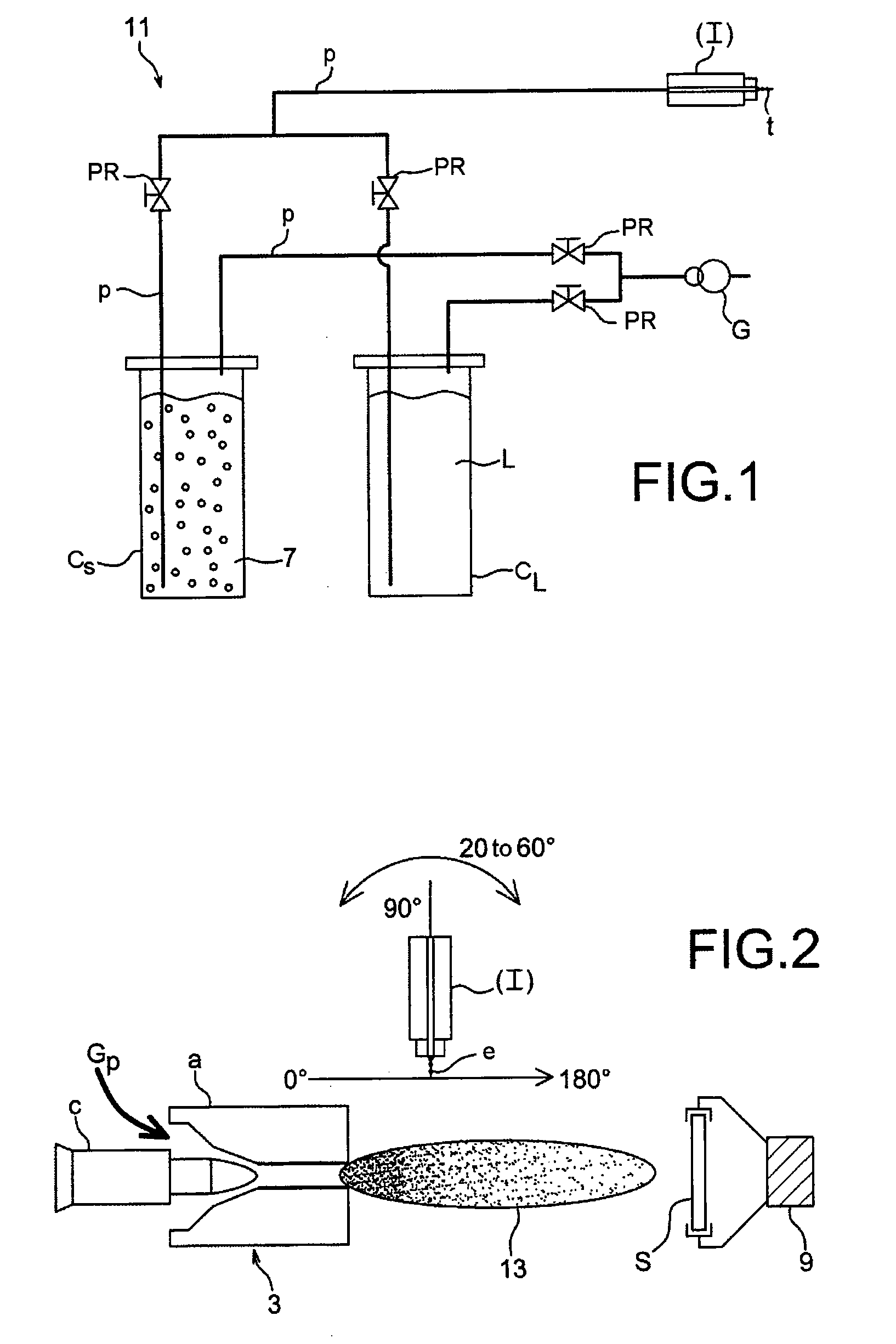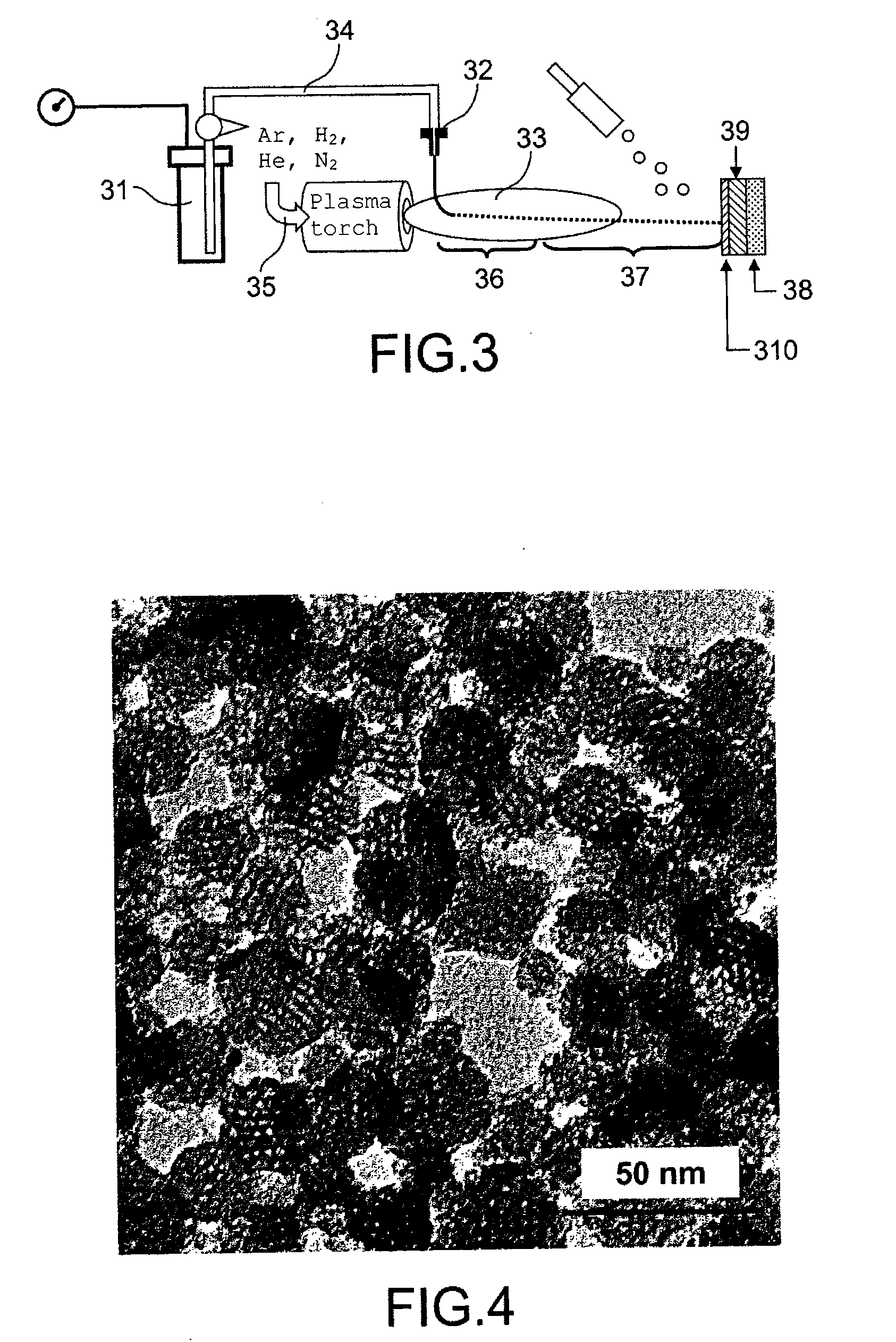Process for Producing a Nanoporous Layer of Nanoparticles and Layer Thus Obtained
a nanoporous layer and nanoparticle technology, applied in the field of nanoporous layer production or forming, can solve the problems of limited dry route, limited liquid/powder (suspension) mixture stability, and no simple implementable technique for obtaining coatings or nanoparticle layers
- Summary
- Abstract
- Description
- Claims
- Application Information
AI Technical Summary
Benefits of technology
Problems solved by technology
Method used
Image
Examples
example 2
[0269]Example 2 describes the manufacture of an ultrafiltration membrane on a ceramic support.
[0270]A porous alumina / titania substrate was produced beforehand by thermal spraying. Its porosity was 35% and its thickness 0.7 mm.
[0271]A 5% aqueous silica sol, with a particle size of 60 nm, was mixed with 7.5 wt % of a monodisperse alumina powder of 150 nm particle size. This mixture was injected into the hot (8000-15000 K) zone of a thermal plasma under the same conditions as in Example 1 and using the same means. A 30 μm thick deposit, film with a pore size of 30 nm, corresponding to the specific requirements of an ultrafiltration membrane, was obtained. The permeance of the multilayer stack (metal support / Al2O3 intermediate layer / selective membrane) was about 800 Sl / min / bar / m2. FIG. 7 is a micrograph of a section through this membrane.
[0272]FIG. 8 may be examined in relation to Examples 1 and 2.
[0273]Example 1 (left-hand diagram in FIG. 8) shows the formation of a membrane having a p...
example 3
[0275]Example 3 describes the production of an ultrafiltration membrane on a ceramic support.
[0276]A 10% aqueous mesoporous silica sol of particle size 40 nm was injected into a thermal plasma under the same conditions as in Example 1 and using the same means.
example 4
[0277]Example 4 describes the production of a phase separation membrane on a ceramic support.
[0278]A porous alumina / titania substrate was produced beforehand by thermal spraying. Its porosity was 35% and its thickness 0.7 mm.
[0279]A 5% aqueous silica sol of particle size 60 nm was mixed with 7.5 wt % of a monodisperse alumina powder of 150 nm particle size. This mixture was injected into a thermal plasma under the same conditions as in Example 1 and using the same means. A film with a thickness of 30 μm and a pore size of 30 nm was obtained.
[0280]The supported membrane was immersed in water at 80° C. for 5 h and then heated in an oven at 110° C. for 10 h. It was then dipped into a fluorinated solvent containing 1% of a fluoroalkoxysilane (CF3(CH2)5Si (OCH3)3) derivative for 48 h. A heat treatment at 130° C. for 1 h 30 min created a covalent bond between the silane and the metal oxide, forming the membrane. The membrane was thus hydrophobic. The contact angle of a water drop was abou...
PUM
| Property | Measurement | Unit |
|---|---|---|
| size | aaaaa | aaaaa |
| pore size | aaaaa | aaaaa |
| porosity | aaaaa | aaaaa |
Abstract
Description
Claims
Application Information
 Login to View More
Login to View More - R&D
- Intellectual Property
- Life Sciences
- Materials
- Tech Scout
- Unparalleled Data Quality
- Higher Quality Content
- 60% Fewer Hallucinations
Browse by: Latest US Patents, China's latest patents, Technical Efficacy Thesaurus, Application Domain, Technology Topic, Popular Technical Reports.
© 2025 PatSnap. All rights reserved.Legal|Privacy policy|Modern Slavery Act Transparency Statement|Sitemap|About US| Contact US: help@patsnap.com



